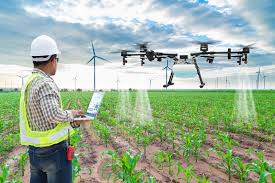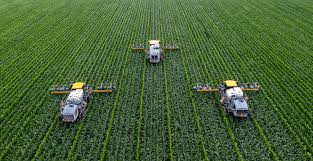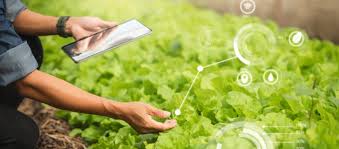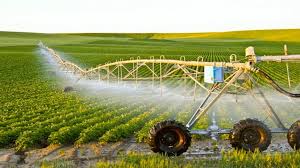The evolution of modern agriculture is a fascinating journey that has transformed human society, shaping economies, cultures, and ecosystems. Agriculture, the practice of cultivating plants and rearing animals for food, fiber, and other products, has undergone significant changes over thousands of years. Initially, ancient societies relied on subsistence farming, where families grew crops and raised livestock to meet their immediate needs. As populations grew, so did the demand for food, leading to innovations in farming techniques and crop management.
The Agricultural Revolution, which began around 10,000 years ago, marked the transition from nomadic lifestyles to settled farming communities. Early farmers developed essential practices such as crop rotation and selective breeding, improving yield and efficiency. Fast forward to the 18th and 19th centuries, and the Industrial Revolution introduced mechanization to agriculture. Innovations like the plow, seed drill, and threshing machine revolutionized production, allowing farmers to cultivate larger areas of land and increase productivity.
In the 20th century, the Green Revolution further transformed agriculture through advancements in biotechnology, fertilizers, and pesticides. These innovations increased crop yields and reduced food scarcity, but they also raised concerns about environmental sustainability and the impact of chemicals on ecosystems.
Today, modern agriculture continues to evolve with the integration of technology. Precision farming, data analytics, and genetically modified organisms (GMOs) are reshaping how food is produced. Sustainable practices and organic farming are gaining traction as society becomes more aware of environmental challenges.
Understanding the evolution of modern agriculture is crucial as it informs our approach to food production and resource management in an increasingly populated world. It highlights the need for innovative solutions that balance productivity, sustainability, and the well-being of future generations.
Historical Overview of Agriculture
Agriculture, one of the pillars of human civilization, has evolved significantly over thousands of years, shaping societies and economies worldwide. Here’s a concise overview of its historical development:
1. Prehistoric Agriculture (10,000 BCE): The journey of agriculture began during the Neolithic period, around 10,000 BCE, when humans transitioned from nomadic hunter-gatherers to settled farming communities. Early agriculture involved the domestication of wild plants and animals, such as wheat, barley, rice, and livestock like sheep and goats. This shift allowed for the establishment of permanent settlements, leading to the rise of civilizations.
2. The Agricultural Revolution (circa 8000-5000 BCE): The Agricultural Revolution marked a significant turning point. As techniques improved, farmers began to practice crop rotation and selective breeding. This period saw the development of tools like the plow, which enhanced productivity. Major agricultural centers emerged in regions such as Mesopotamia, Egypt, the Indus Valley, and China, where irrigation systems were developed to manage water supply for crops.
3. Classical and Medieval Agriculture (500 BCE – 1500 CE): During classical antiquity, agriculture became more sophisticated with the introduction of advanced irrigation techniques and farming methods. The Roman Empire made significant contributions, including the use of fertilizers and crop rotation. In medieval Europe, agriculture was characterized by the feudal system, where peasants worked on lands owned by nobles. The introduction of the three-field system improved soil fertility and crop yields.
4. The Age of Exploration and Colonization (15th – 18th Century): The Age of Exploration led to the exchange of crops and agricultural practices across continents, known as the Columbian Exchange. New World crops such as potatoes, maize, and tomatoes were introduced to Europe, revolutionizing diets and agricultural practices. The demand for cash crops like sugar, tobacco, and cotton drove the establishment of plantations, often relying on slave labor.
5. The Industrial Revolution (18th – 19th Century): The Industrial Revolution brought about significant changes in agriculture with the introduction of mechanization. Inventions such as the seed drill, mechanical reaper, and threshing machine increased efficiency and productivity. This period also saw the rise of agricultural science, with the development of fertilizers and pesticides to enhance crop yields.
6. The Green Revolution (Mid-20th Century): The Green Revolution, beginning in the 1940s, introduced high-yielding varieties of crops, advanced irrigation techniques, and synthetic fertilizers. This movement significantly increased food production in developing countries, helping to combat hunger and famine. However, it also raised concerns about environmental degradation, pesticide use, and loss of biodiversity.
7. Modern Agriculture (21st Century): Today, agriculture is characterized by technological advancements such as precision farming, biotechnology, and sustainable practices.
Innovations in data analytics, drones, and genetic engineering are reshaping food production, while there is a growing emphasis on sustainability and organic farming to address environmental challenges.
Advances in Farming Technology

Technological advancements in agriculture have played a crucial role in increasing food production and efficiency. Here are some key technologies that have transformed farming:
1. Plows: The invention of the plow allowed for deeper soil cultivation, making it easier to grow crops and increasing yields.
2. Irrigation Systems: The development of irrigation technology enabled farmers to divert water from rivers and lakes, allowing them to cultivate arid lands and improve crop reliability.
3. Fertilizers: Chemical fertilizers have enhanced soil fertility, providing essential nutrients to crops, leading to higher yields and more robust harvests.
4. Pesticides: The introduction of synthetic pesticides has helped control pests and diseases, protecting crops and ensuring better food quality.
5. Agricultural Machinery: The use of tractors, seeders, and harvesters has revolutionized farming practices, reducing labor costs and increasing productivity.
The Role of Mechanization in Agriculture
Mechanization has fundamentally changed the landscape of agriculture. Here are the critical roles mechanization plays:
1. Increased Efficiency: Mechanization allows farmers to complete tasks faster, such as planting, cultivating, and harvesting, which boosts overall productivity.
2. Reduced Labor Costs: Machines can perform the work of many hands, leading to lower labor expenses and enabling farmers to manage larger areas of land.
3. Consistency in Operations: Machinery provides uniformity in planting depth, spacing, and harvesting, leading to more consistent crop quality.
4. Improved Safety: Modern machinery reduces the physical demands on farmers, decreasing the risk of injuries associated with manual labor.
5. Precision Agriculture: Advanced technologies, such as GPS and sensors, allow for more precise farming techniques, optimizing inputs and improving sustainability.
Raed Also: Blackleg (cruciferous plants): Description, Damages Caused, Control and Preventive Measures
The Green Revolution: Transforming Crop Production

The Green Revolution, which began in the mid-20th century, introduced new agricultural techniques and high-yielding crop varieties. Here’s how it transformed crop production:
1. High-Yielding Varieties (HYVs): Scientists developed HYVs of staple crops like wheat and rice that produce more grain per plant, significantly increasing overall food production.
2. Improved Irrigation: The Green Revolution promoted advanced irrigation methods, allowing for better water management and increased crop reliability.
3. Chemical Inputs: The increased use of fertilizers and pesticides enhanced crop growth and protection, resulting in higher yields.
4. Agricultural Research: Research institutions played a vital role in developing new technologies, educating farmers, and improving agricultural practices.
5. Infrastructure Development: Investments in rural infrastructure, such as roads and storage facilities, facilitated the distribution of agricultural products, enhancing market access.
The Impact of Biotechnology on Agriculture
Biotechnology has introduced innovative approaches to crop production and animal husbandry. Here are some significant impacts:
1. Genetically Modified Organisms (GMOs): Biotech crops are engineered for traits like pest resistance, herbicide tolerance, and improved nutritional content, resulting in higher yields and reduced chemical use.
2. Disease Resistance: Biotech methods have produced plants that are resistant to diseases, reducing crop losses and enhancing food security.
3. Enhanced Nutritional Quality: Biotechnology allows for the fortification of crops with essential vitamins and minerals, addressing malnutrition in developing regions.
4. Sustainable Practices: Biotech solutions can reduce the need for chemical inputs, leading to more sustainable agricultural practices and lower environmental impacts.
5. Crop Adaptation: Biotechnology can help develop crops that are resilient to climate change, such as drought-tolerant varieties, ensuring food production in changing environments.
The Rise of Organic Farming
Organic farming has gained popularity as consumers seek healthier and more environmentally friendly food options. Here are key aspects of this rise:
1. Health Consciousness: Growing awareness of health issues related to synthetic chemicals has led consumers to prefer organic produce, which is grown without harmful pesticides or fertilizers.
2. Environmental Benefits: Organic farming promotes biodiversity, improves soil health, and reduces pollution by avoiding synthetic inputs, making it a more sustainable choice.
3. Market Demand: The increasing demand for organic products has driven farmers to adopt organic practices to capitalize on higher prices and consumer interest.
4. Certification Programs: Organizations and government bodies have established certification programs, ensuring that organic products meet specific standards and building consumer trust.
5. Community Support: Local farmers’ markets and community-supported agriculture (CSA) programs have emerged, connecting consumers directly with organic farmers and fostering local economies.
Precision Agriculture: Enhancing Efficiency
Precision agriculture employs technology to improve crop management and resource use. Here are the main components:
1. GPS Technology: Farmers use GPS to map fields, allowing for precise planting and application of inputs, reducing waste and increasing efficiency.
2. Drones and Sensors: Drones and soil sensors provide real-time data on crop health, soil moisture, and nutrient levels, enabling targeted interventions.
3. Data Analytics: Analyzing data from various sources helps farmers make informed decisions about irrigation, fertilization, and pest control, leading to better resource management.
4. Variable Rate Technology (VRT): VRT allows farmers to apply fertilizers and pesticides at variable rates across their fields based on specific needs, optimizing input use.
5. Environmental Impact: By using resources more efficiently, precision agriculture reduces environmental impacts, such as runoff and soil degradation.
Raed Also: Blackleg (cruciferous plants): Description, Damages Caused, Control and Preventive Measures
The Influence of Climate Change on Agriculture

Climate change poses significant challenges to agriculture, affecting crop production and food security. Here’s how:
1. Changing Weather Patterns: Altered rainfall patterns and increased temperatures can disrupt traditional farming practices, leading to crop failures and reduced yields.
2. Pests and Diseases: Warmer temperatures may expand the range of pests and diseases, threatening crops and livestock and leading to increased pesticide use.
3. Water Scarcity: Climate change can exacerbate water shortages, making irrigation more challenging and impacting crop growth.
4. Soil Erosion: Extreme weather events, such as heavy rainfall and flooding, can lead to soil erosion, reducing land productivity and increasing the need for sustainable soil management practices.
5. Adaptation Strategies: Farmers must adopt adaptive practices, such as crop rotation, drought-resistant varieties, and improved water management, to mitigate the impacts of climate change.
Globalization and Agriculture
Globalization has transformed agriculture, impacting production, trade, and food systems. Here are some key points:
1. International Trade: The globalization of agriculture has facilitated the exchange of agricultural products between countries, leading to greater market access and diversification.
2. Commodity Markets: Globalization has created interconnected commodity markets, influencing prices and production decisions worldwide.
3. Agricultural Innovation: The global exchange of knowledge and technology has spurred innovations in agricultural practices, enhancing productivity and sustainability.
4. Food Security: Globalization can improve food security by providing access to a variety of foods year-round, but it can also make countries vulnerable to global market fluctuations.
5. Environmental Concerns: Increased agricultural production to meet global demand can lead to environmental degradation, necessitating sustainable practices to balance productivity with ecological health.
Do you have any questions, suggestions, or contributions? If so, please feel free to use the comment box below to share your thoughts. We also encourage you to kindly share this information with others who might benefit from it. Since we can’t reach everyone at once, we truly appreciate your help in spreading the word. Thank you so much for your support and for sharing!

